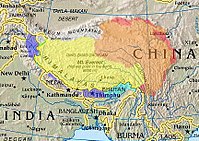
Photo from wikipedia
Using observational data from 1979–2015 and a linear baroclinic model (LBM), the present study examined the impact of autumn snow cover (ASC) over the western Tibetan Plateau (WTP) on the… Click to show full abstract
Using observational data from 1979–2015 and a linear baroclinic model (LBM), the present study examined the impact of autumn snow cover (ASC) over the western Tibetan Plateau (WTP) on the subsequent spring precipitation over southern China (SPSC). Focus was placed on the interannual time scale of the snow-precipitation relationship. The ASC over the WTP is positively correlated with the SPSC, and this snow-precipitation relationship is independent of sea surface temperature anomalies over the tropical Indo-Pacific regions. When the ASC over the WTP is more extensive than normal, in the following spring, anomalous southerly winds over eastern China occur and transport water vapor northward from the tropical ocean to the interior of the continent, which is favorable for more SPSC. Further analysis of the energy budget shows that the anomalous ASC over the WTP persists to the following spring because of local positive snow-air feedback. Higher-than-normal ASC over the WTP can cool the above atmosphere and is associated with pronounced negative geopotential height anomalies that dominate in the East Asian-western North Pacific region. These negative height anomalies lead to a weakened and northward-shifted spring East Asian subtropical jet (EASJ). The changes in the spring EASJ lead to divergent anomalies at the upper level over the upstream as well as the central areas of the EASJ; therefore, anomalous low-level convergence and ascent motion dominate over coastal East Asia and in nearby regions, providing a favorable environment for positive SPSC anomalies.
Journal Title: Climate Dynamics
Year Published: 2020
Link to full text (if available)
Share on Social Media: Sign Up to like & get
recommendations!